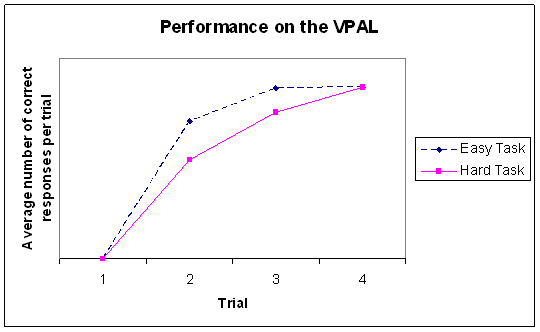|
||||
Tuesday, October 23, 2007
P3-19
USING LATENT GROWTH MODELING TO ASSESS THE PROPERTIES OF A NEUROPSYCHOLOGICAL TEST OF MEMORY
Purpose: Neuropsychological tests assessing episodic memory incorporate repeated observations across learning trials. However, psychometric properties are not studied because the analyses require independent observations. Here we pilot the use of latent growth modeling (LGM), a special case of structural equation modeling used for analyzing longitudinal data, to determine properties of the Verbal Paired Associate Learning Test (V-PAL).
Method: The V-PAL was administered to 582 healthy participants, 17-24 years of age. The test includes an easy associate task (EAT) consisting of 5 semantically-related pairs of words administered in 4 learning trials, and a hard associate task (HAT), consisting of 5 pairs of semantically-unrelated words administered similarly. The total number of correct responses per trial indicated the degree of successful recall. Separate analyses were used to model performance for each task and a third analysis modeled both components simultaneously. Model acceptability was based on 2 criteria: (1) overall fit, as indicated by the Bollen-Stine p (to compensate for violation of multivariate normality), the comparative fit index (CFI), and the root mean square error of approximation (RMSEA) and (2) significant parameters. Standard conventions for fitting latent growth models were applied. However, rather then impose a form (e.g. quadratic curve) we allowed the software (AMOS 6.0) to identify the one that reflected participants' mean performance by constraining the slope for the first trial and last trial and allowing the other slopes to be freely estimated.
Results: Performance on the EAT was better than on the HAT, but subjects demonstrated logarithmic-like improvement across both tasks (Figure 1). All 3 models demonstrated good fit (Bollen-Stine p=0.08-0.98, CFI=0.98-1.00, RMSEA=0.00-0.08). Parameters were significant (p<0.01), indicating (1) high initial scores and significant improvement across trials, (2) a high degree of individual variability initially and across trials, and (3) greater improvement among subjects who scored lower on the 1st observation.
Conclusions: Although LGM typically is used for longitudinal research, it can be appropriated for memory tests that involve repeated administrations of the same stimuli. Now that a latent structure has been identified, future studies can assess properties of the V-PAL, such as invariance, which is necessary for ensuring diagnostic accuracy.
Figure 1


